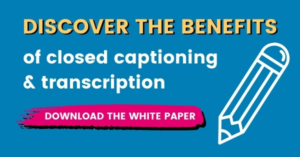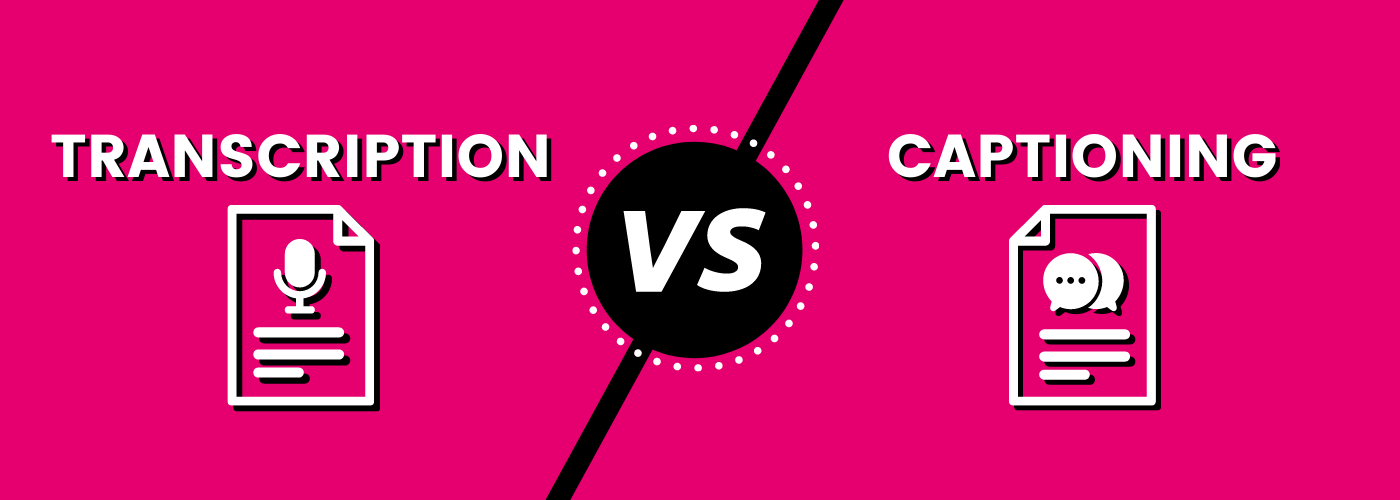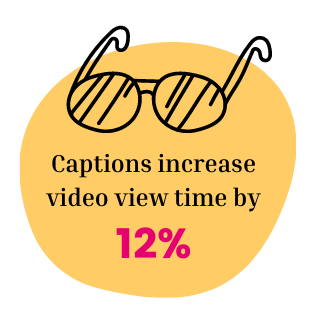Transcription vs. Captioning – What’s the Difference?
Updated: August 23, 2021
Ever wondered how transcription vs. captioning compare to one another? The difference goes beyond mere dictionary definitions – while transcription & captioning each have their own respective uses, benefits, and legal requirements, they can also work together to create more accessible & user-friendly content.
Transcription refers to the process by which audio is converted into written text, whereas captioning divides that transcript text into time-coded chunks, known as “caption frames.”
Though transcription forms the basis of captioning, each process has respective use cases. While transcription can be used to make audio-only content accessible, accurate closed captions are legally required to make videos accessible. Both, however, can help boost video SEO!
Transcription vs. Captioning
Transcription is the process by which speech or audio is converted into a written, plain text document. As the plain-text output of transcription, the transcript itself will not have any time information attached to it. There are two primary ways transcripts can be written:
- Verbatim transcribes the audio word-for-word (including all utterances and sound effects), and is usually most beneficial for scripted speech like a TV show, movie, or skit
- Clean read transcription edits the text to read more fluidly, and is better for unscripted content like interviews & recorded speaking events
Captioning is a process that involves splitting transcript text into chunks (known as “caption frames”) & time-coding each frame to synchronize with the audio of a video. Output typically appears at the bottom of a video screen, and should always depict speech & sound effects, identify speakers, and account for any sound that is not visually apparent.
Benefits of Transcription vs. Captioning
Transcription benefits
Transcription is a beneficial supplement to your video & audio content, but first and foremost, it’s a useful accessibility tool! If you’re not using a professional transcription/captioning service, then writing transcripts can be the perfect introduction to creating closed captions in-house.
When it comes to media formats like a podcast or radio show, transcripts not only make the content accessible, but they also have the potential to improve comprehension for ESL (English as a second language) listeners, increase overall user interaction, and boost SEO online. The popular podcast This American Life transcribed 100% of their audio archives and in return, saw a 6% increase in unique site visitors through organic search results & a further 4% increase in inbound link traffic.
But transcription doesn’t solely benefit radio shows – it works for video content, too! Since search engines can’t physically watch a video, they have no way or ranking video content based on more than metadata. Transcripts (and caption files) let search engines to “read” the video’s content, which allows the video to be properly indexed and ranked on results pages.
Captioning benefits
Closed captions offer several benefits… as long as they’re accurate. Captions are necessary (and often legally required!) to make video content accessible to d/Deaf or hard of hearing viewers. On top of that, they can prove helpful to viewers with learning disabilities or attention deficits to maintain focus, as well as make it easier for ESL speakers to follow along.
A study conducted by Facebook found that almost 41% of video is incomprehensible without sound or captions. Not only do captions help people with the comprehension of dialogue, but they also allow viewers to watch video in sound-sensitive environments like a quiet office or on public transportation. The same Facebook study found that combining these efforts could lead to more eyes on your videos – captions increased view time by 12%!
Accessibility of Transcription vs. Captioning
Making video and audio content accessible is important for many reasons, mainly because it allows all viewers the opportunity to consume media and because it’s the law.
While accessibility is important in its own rite, when considering transcription vs. captioning for your video content it’s just as important to ensure your content is fully accessible in order to be compliant with the law.
Is Transcription Enough to Meet Accessibility Laws?
The short answer is no. Let’s talk about why:
The Americans with Disabilities Act (ADA) requires that an equivalent experience must be made for d/Deaf and hard of hearing people. Because of the fact that transcripts are not time-coded, it doesn’t allow viewers with hearing loss to follow along with the content in real time. As such, captions must be provided in order to provide the equitable experience that is legally mandated.
Under the Rehabilitation Act of 1973, compliance with WCAG 2.0 AA Standards is required. These standards state that captioning must be provided for all pre-recorded and live video.
In summary, transcription and transcripts are not enough to make video accessible in compliance with the law.
Download the (free!) Rehabilitation Act eBook ➡️
Transcription, Captioning, and Accessibility
Just because transcription alone isn’t enough to legally comply with accessibility standards, that doesn’t mean it has no place in making your content accessible. Here’s how transcripts contribute to accessibility:
- the first step in creating captions for video & many DIY methods
- the best way to make radio shows accessible
- simple to translate into other languages for global accessibility
- helpful to those with autism, attention deficits, & learning disabilities, or who speak English as a second language
Thinking about transcriptions and captioning?
3Play Media offers premium transcription and captioning services with a 99% guaranteed accuracy rate. Get started today!









